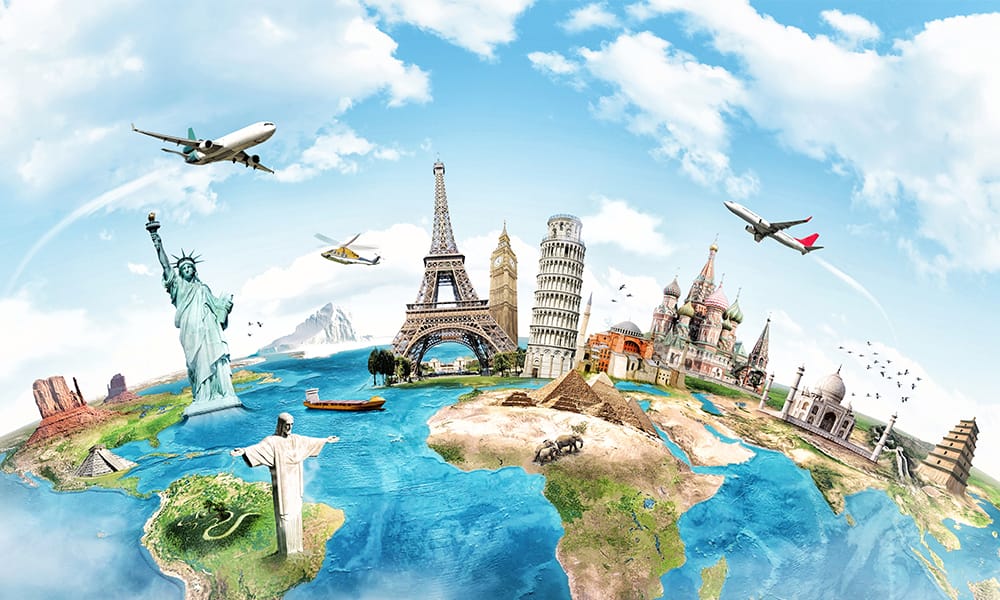- 1
- 2
- 3
- 4
- 1Destinations
- 2Trip Date
- 3Travellers
- 4Medical history
Popular Destinations

Now covers COVID-19
What is Nepal Famous For?
We all know that Nepal is home to the world's highest mountain peak, Mount Everest. Besides Everest, it has 8 out of the world's 14 highest peaks. If you are wondering what Nepal is famous for other than the Himalayas, you must know it is a beautiful country that offers innumerable experiences to its visitors. While trekkers make a beeline to experience the thrill of adventure, spiritual seekers find peace in Nepal's ancient temples and local traditions. Whether you seek adventure, spiritual enlightenment, or new cultural experiences, Nepal is the perfect destination.
Travel Insurance Plans on PolicyBazaar#1
- Individuals
- Sr. Citizens
- Students
Why Nepal is Now on Everybody's Bucket List
Nepal is now one of the world's favourite travel destinations—and it's easy to see why.
- It is a retreat for hikers, trekkers and mountaineers. With Mount Everest and other towering peaks, Nepal's mountains are a challenging expedition for them.
- Apart from treks and hikes, Nepal offers a variety of exciting activities for adventure lovers. You can indulge in thrilling activities like paragliding, white-water rafting, and bungee jumping.
- Nepal attracts many religious travellers or spiritual seekers who come to Lumbini, the birthplace of Lord Buddha and Pashupatinath Temple.
- Nepal has something in store for every traveller, from natural beauty to cultural richness. You come back home with a unique experience.
7 Reasons Why Nepal is So Famous
Nepal has always been popular for its peaks, but other than towering mountains, its rich culture and warm hospitality are turning it into a popular travel hotspot. It's a perfect mix of adventure, spirituality, and natural beauty—all in one place.
1. Majestic Himalayan Peaks
From stunning views and perfect sunrise/sunset scenes to wildlife diversity and mountaineering adventures, you find them all when you go to the Himalayas in Nepal.
- Eight of the world's fourteen highest mountains are located in Nepal, including the world's highest mountain, Mount Everest.
- These towering peaks offer unparalleled opportunities for trekking, mountaineering, and breathtaking views.
- The Everest Base Camp and Annapurna Circuit treks attract adventurers from around the globe. The Himalayas are also deeply venerated by others who believe the mountain range is holy.
2. Rich Cultural Heritage
Nepal offers a diverse culture and religious traditions. The reasons for its dynamic cultural heritage are many:
- Nepal's culture is a blend of Hinduism, Buddhism, and other indigenous ethnic traditions.
- The Kathmandu Valley alone boasts seven UNESCO World Heritage Sites, including ancient temples, palaces, and stupas.
- Newari architecture and crafts can be best experienced in Bhaktapur and Patan.
- Local festivals like Dashain and Tihar offer an insight into the lively music, dance and rituals.
3. Adventure Activities
Nepal is a paradise for adventurers, not just trekkers.
- The Trishuli and Bhote Koshi rivers are popular destinations for white-water rafting. Depending on whether the river rafting is suited for beginners or if it is moderately challenging, you can choose where to go for rafting.
- You can also enjoy paragliding in Pokhara, offering stunning Himalayas and Phewa Lake views.
- Bungee jumping and zip-lining are also available at several places in Nepal for those seeking an adrenaline rush.
4. Diverse Wildlife and National Parks
Nepal's varied ecosystems support a rich array of wildlife.
- Chitwan National Park, a UNESCO World Heritage Site, is home to Bengal tigers, one-horned rhinoceroses, and Asian elephants.
- Bardia National Park offers a more secluded experience with similar biodiversity. Birdwatchers can delight in over 900+ species found throughout the country.
- Jungle safaris, canoe rides, and guided nature walks offer immersive experiences to explore Nepal's diverse natural habitats.
5. Spiritual and Religious Significance
Nepal is a spiritual sanctuary, where the country's landscape is dotted with sacred sites.
- It boasts religious hubs, including the Pashupatinath Temple, Lumbini and the Swayambhunath Stupa.
- Pilgrims and spiritual seekers flock to these locations for meditation, prayer, and reflection.
- Monasteries and ashrams offer retreats and teachings in various spiritual disciplines.
- Lumbini is revered as the birthplace of Lord Buddha. It is listed as a UNESCO World Heritage Site.
6. Warm and Hospitable People
Nepali people are renowned for their warmth and hospitality.
- The traditional saying 'Atithi Devo Bhava,' meaning 'The guest is God,' reflects the country's welcoming ethos.
- Visitors often find themselves invited into homes for meals and cultural exchanges.
- Homestays and community-based tourism initiatives allow travellers to experience daily life and traditions firsthand.
7. Affordable Travel Destination
Nepal offers great value for those travelling on a budget, with cheap accommodation, food and transport.
- Budget-friendly options are plentiful, ranging from guesthouses to small, local restaurants serving delicious Nepali cuisine.
- Even guided treks and adventure sports are affordable compared to other locations. This affordability makes Nepal accessible to a wide range of travellers, from backpackers to luxury seekers.
- Indian tourists have an advantage, as 1 INR equals 1.60 Nepali Rupees. Similarly, European and other Western tourists will find Nepal an even more low-cost travel destination.
Top 5 Nepal Tourist Places
Nepal is a country of many contrasts – breathtakingly beautiful terrains, cultural heritage and spiritual significance. From the crowded streets of Kathmandu to the relaxation of Pokhara, there is something of interest for every traveller. Here are some top places in Nepal that you can add to your Nepal itinerary.
-
Kathmandu
Nepal's capital, Kathmandu, is a blend of old and new, with centuries-old stupas and crumbling shrines set against vibrant markets and urban sprawl. From its energetic markets to its historical buildings and plethora of festivals, Kathmandu is a city that should be added to your list of cultural experiences. -
Pokhara
Pokhara, the 'Tourist Capital of Nepal', is renowned for its natural beauty. Situated alongside the Phewa Lake with a panoramic view of the Annapurna range, the peace and beauty make it feel like a paradise. For the adventurous, there are plenty of activities, such as paragliding, trekking, boating, and catamaran rides, making it the preferred choice for adrenaline junkies. -
Lumbini
Located in the Rupandehi District, Lumbini is the revered birthplace of Lord Buddha. This UNESCO World Heritage Site attracts pilgrims and tourists alike, offering a serene environment for meditation and reflection. Key attractions include the Maya Devi Temple, the Bodhi Tree and the World Peace Pagoda, each of which holds significant historical and spiritual value. -
Chitwan National Park
Nestled in Nepal's southern region, Chitwan National Park attracts wildlife enthusiasts worldwide. It has UNESCO World Heritage Site status, providing a home to Bengal tigers, one-horned rhinoceros and numerous varieties of birds. Jungle safaris, canoe rides, and guided nature walks allow visitors to experience the park's abundant biodiversity. -
Bhaktapur
Home to the Newari culture, Bhaktapur is one of the three historic cities in the Kathmandu Valley. The city is famous for its traditional architecture, vibrant artists, and temples and palaces that reflect its rich cultural heritage. The city's well-preserved medieval structures, including the Bhaktapur Durbar Square, Nyatapola Temple, and Changu Narayan Temple, offer a glimpse into Nepal's rich cultural heritage. Wandering through its tiny, cobbled lanes, tourists can see time-honoured pottery, woodcraft, and vibrant festivals, which have been shaped by a history that still imbues this city.
Best Time to Visit Nepal
The best time to travel to Nepal is the end of September to November. During this time, the skies are clear, and the temperatures are warm. Spring (March–April) is one of the busiest tourist seasons, as one can see blooming rhododendrons and enjoy various local festivals, including Holi. Winter is quiet and is excellent for low-altitude treks, but the monsoon (June-August) makes travelling less ideal.
Tips for Indians Travelling to Nepal
Here are a few things you should know before travelling to Nepal that can help you with a seamless tour experience.
-
No Visa Needed
Indian citizens do not require a visa to enter Nepal. You must carry either your original Indian passport or Voter ID card issued by the Election Commission of India with you for entry into Nepal.
-
Carry Cash
Tourists are also advised to carry sufficient cash, as there are only a few credit card terminals and limited ATMs in rural Nepal. INR (Indian Rupees) are commonly accepted in Nepal, but carrying some NPR (Nepal Rupees) is better for convenience.
-
Respect Local Customs
Respect and tradition are of great importance in Nepalese culture. When visiting temples and monasteries, tourists are expected to remove their shoes and wear modest clothing. Always ask permission before photographing people and religious items.
-
Protect your Health
It's advisable to drink only bottled or purified water to avoid waterborne illnesses. Keep a basic first aid kit and a supply of medicines. Also, see a doctor first for guidance on altitude sickness if you plan to hike.
-
Travel Insurance
While travel insurance is not mandatory to visit the country, signing up for one is a good idea. Purchasing comprehensive travel insurance for Nepal that covers medical emergencies, trip cancellations, and other unexpected situations is highly recommended.
Nepal: Where Adventure Meets Tradition
Nepal is a land of beautiful snow peaks, crystal-clear air, colourful ancient history, religions and charming traditions. Aside from being an adventurous playground, it's a vibrant cultural region filled with colourful festivals, local music, distinct art and architecture. It is made warm by the body heat of the Nepalese, who add to its snug charm. So whatever you are looking for, whether it is a natural idyll, a cultural visit or some inner peace, Nepal has got you covered.
What is Nepal Famous For?: FAQs
-
Q1: What are the best dishes of Nepal?
Ans: The most popular foods among the tourists in Nepal are as follows:- Dal Bhat – lentil soup and rice, with vegetable curry sauce.
- Momos - steamed dumplings, stuffed with meat or veg.
- Thupka - noodle soup.
- Sel Roti - sweet rice bread
-
Q2: What can I buy as a souvenir in Nepal?
Ans: Nepal offers a diverse range of speciality souvenirs that showcase its rich cultural heritage and exceptional craftsmanship. The most popular items are Pashmina shawls, singing bowls, Thangka paintings, Khukuri knives, and Lokta paper products./div> -
Q3: What documents are required for trekking in Nepal?
Ans: All trekkers are required to have a medical certificate signed by a licensed physician confirming their fitness for a high-altitude trek. -
Q4: Is Cambodia safe for Indians travelling solo?
Ans: Yeah, mostly. Just keep your eyes open, look after your stuff, and skip quiet places late at night—and you will be fine. -
Q5: Do I need special permission to climb Mount Everest?
Ans: Yes. To climb Mount Everest, the tourist must:- Have prior experience on a Nepalese peak over 6,500 meters.
- Obtain a medical fitness certificate.
- Hire a licensed Nepali guide.
- Obtain a government-issued permit (including fee and rescue insurance).
STANDARD TERMS AND CONDITIONS APPLY. For more details on risk factors, terms, and conditions, please read the sales brochure carefully before concluding a sale.
Policybazaar Insurance Brokers Private Limited, Registered Office - Plot No.119, Sector - 44, Gurgaon, Haryana - 122001 | CIN: U74999HR2014PTC053454 | Policybazaar is registered as a Composite Broker | Registration No. 742, Valid till 09/06/2027 | License category - Composite Broker | Contact Us | Legal and Admin Policies
*Price shown is for a 180 day trip to Thailand with 50 thousand dollar coverage for an adult of age 25 years































